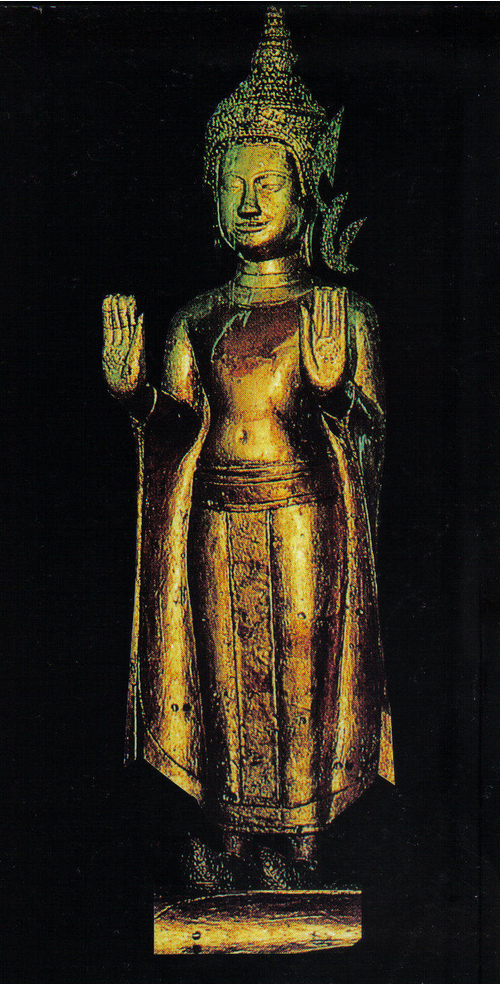ค้นหางานศิลปกรรม
ฐานข้อมูลศิลปกรรมในเอเชียตะวันออกเฉียงใต้
จิตรกรรมจิตรกรรมเรื่องออกมหาภิเนษกรมณ์และมารวิชัย
อิทธิพลรัตนโกสินทร์ที่ปรากฏในภาพเขียน เช่น การวาดภาพปราสาทราชวังและตัวละคร รวมถึง การวาดท้องฟ้าสีฟ้าและทัศนียวิทยาตามแบบความเป็นจริงซึ่งแสดงให้เห็นการเข้ามาของอิทธิพลตะวันตก จิตรกรรมนี้จึงอาจเกี่ยวข้องกับศิลปะรัตนโกสินทร์ในสมัย รัชกาลที่ 4-5
ประติมากรรมบานประตูของสิมวัดองค์ตื้อ
ในรัชกาลสมเด็จเจ้ามหาชีวิตศรีสว่างวงศ์ ได้เกิดสกุลช่างไม้สลักขึ้นในหลวงพระบาง โดยสกุลช่างดังกล่าวนิยมสลักภาพเทวดาทับลงไปบนลายพันธุ์พฤกษาที่เป็นก้านขดอกดอกโบตั๋น ตัวอย่างของภาพสลักในสกุลช่างนี้ยังสามารถเห็นได้อีกที่ประตูของสิมวัดวิชุลเมืองหลวงพระบาง
สถาปัตยกรรมพระพุทธรูปที่ถ้ำช้าง
พระพุทธรูปในศิลปะทวารวดีภาคอีสาน มีลักษณะเด่นหลายประการ เช่น การที่พระพักตร์มีลักษณะแบบพื้นบ้าน เม็ดพระศกเล็กและวมขึ้นอันแสดงอิทธิพลขอมที่เข้ามาปะปน พระหัตถ์แสดงปางวิตรรกมุทราซึ่งเป็นมุทราที่โดดเด่นในศิลปะทวารวดี พระเพลาขัดสมาธิราบแบบหลวมๆและเห็นฝ่าพระบาทจากด้านบนซึ่งเป็นลักษณะเฉพาะในสมัยนี้เช่นกัน
ประติมากรรมพระบาง
พระบางมีลักษณะเป็นพระพุทธรูปในศิลปะขอมสมัยหลังบายน คือมีเม็ดพระศกเล็กเป็นหนามขนุน ห่มคลุม แสดงปางประทานอภัยสองพระหัตถ์ ด้านหน้าของสบงมีจีบหน้านางอันแสดงให้เห็นความเกี่ยวข้องกับศิลปะเขมร
ประติมากรรมพระเจ้าองค์ตื้อ
พระพุทธรูปองค์นี้มีลักษณะเป็นพระพุทธรูปในศิลปะล้านช้างในสมัยพระเจ้าไชยเชษฐาโดยทั่วไป คือ มีพระพักตร์รูปไข่และรัศมีเป็นเปลวตามอิทธิพลของสุโขทัยและล้านนา ห่มเฉียงตามแบบที่นิยมในพระนั่ง แสดงปางมารวิชัยซึ่งนิยมกับพระพุทธรูปนั่งเช่นกัน ด้านล่างปรากฏ “กลีบบัวรวน” ซึ่งเป็นความนิยมในศิลปะล้านช้าง ต้องไม่ลืมพระรัชกาลพระเจ้าไชยเชษฐาเป็นรัชกาลที่มีการติดต่อสัมพันธ์กับล้านนาและอยุธยาอย่างมาก ด้วยเหตุนี้พระพุทธรูปองค์นี้จึงสะท้อนอิทธิพลทางศิลปกรรมจากดินแดนดังกล่าวด้วย
ประติมากรรมฐานของพระพุทธรูปสำริด
ในพุทธศตวรรษที่ 22-24 พระพุทธรูปในศิลปะล้านช้างมักมีฐานที่สูงและมีลวดบัวที่ซับซ้อน โดยฐานมักหล่อเป็นสำริดเช่นเดียวกับ ฐานมักประกอบด้วยฐานสิงห์ซึ่งมีกาบเท้าสิงห์ประกอบไปด้วยวงโค้งต่อเนื่องกันคล้ายศิลปะอยุธยาตอนกลาง ถัดขึ้นมาได้แก่บังคว่ำและท้องไม้ซึ่งคาดลูกแก้วอกไก่ ถัดขึ้นไปคือบัวหงายประกบบัวคว่ำอันเป็นการลดความแข้งกระด้างของหน้ากระดานบนและทำให้ฐานสามารถแสดงการ “งอน” ได้ตามต้องการ การงอนนี้ถือเป็นสุนทรียภาพสำคัญของลวดบัวในศิลปะล้านช้าง
ประติมากรรมพระพุทธรูปสำริด
ในพุทธศตวรรษที่ 22-24 พระพุทธรูปในศิลปะล้านช้างมีลักษณะเด่นหลายประการ เช่น การที่พระพักตร์มีลักษณะแบบพื้นบ้าน เม็ดพระศกเล็กและมีไรพระศก พระเศียรโตแต่พระอังสาแคบ พระวรกายผอมสูง จีวรเรียบไม่มีริ้ว มีชายผ้าหน้างด้านหน้าตามแบบอิทธิพลอยุธยา แต่ชายจีวรมีการกระดกขึ้นซึ่งลักษณะหลังถือเป็นลักษณะเฉพาะของล้านช้าง
ประติมากรรมพระพุทธรูปสำริด
ในพุทธศตวรรษที่ 22-24 พระพุทธรูปในศิลปะล้านช้างมีลักษณะเด่นหลายประการ เช่น การที่พระพักตร์มีลักษณะแบบพื้นบ้าน เม็ดพระศกเล็กและมีไรพระศก พระเศียรโตแต่พระอังสาแคบ พระวรกายผอมสูง จีวรเรียบไม่มีริ้ว มีชายผ้าหน้านางด้านหน้าตามแบบอิทธิพลอยุธยา แต่ชายจีวรมีการกระดกขึ้นซึ่งลักษณะหลังถือเป็นลักษณะเฉพาะของล้านช้าง ที่น่าสนใจก็คือพระพุทธรูปองค์นี้ที่ปลายจีวรมีการขมวดม้วนเป็นลายก้นหอยซึ่งปรากฏเช่นกันกับพระพุทธรูปปูนปั้นประดับเจดีย์บางองค์ในเมืองเวียงจันทน์


